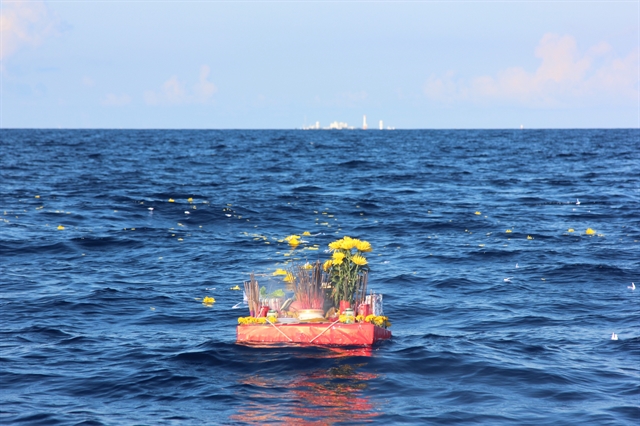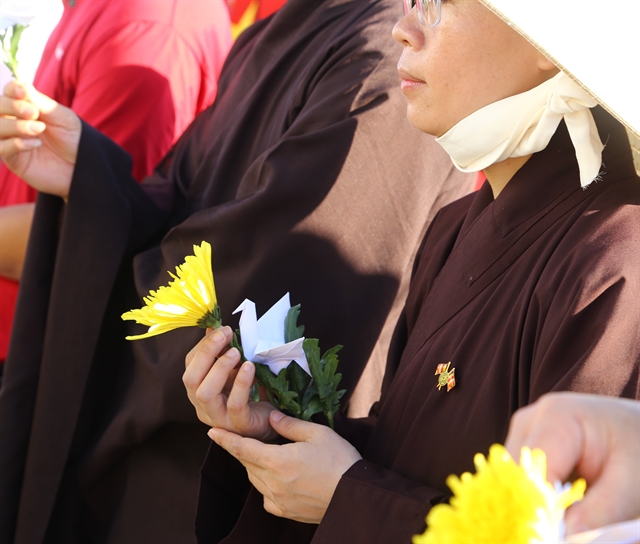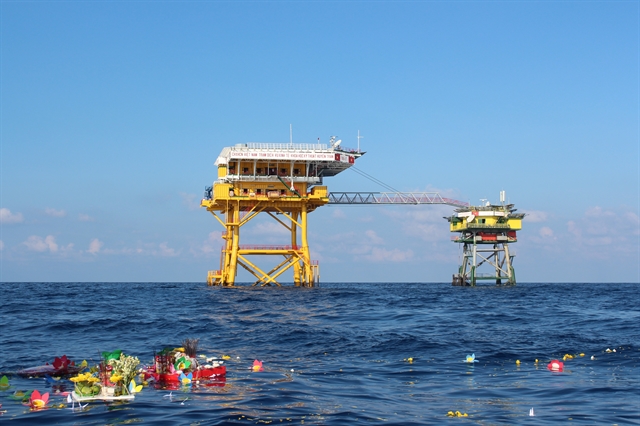
WAVES OF EMOTION: An incense-burner floats off the Trường Sa (Spratly) Archipelago with Gạc Ma (Johnson South) Reef on the background in commemoration of 64 naval soldiers who died while fighting to protect the reef from Chinese invaders in 1988. VNS Photos Hồng Minh
By Hồng Minh
Memorial ceremonies are always emotional. And the emotions are sure to bubble up in a stronger and more special way when the ceremonies take place at spots where the martyrs spent their final minutes.
For many travellers who are lucky enough to visit Việt Nam’s territorial waters in Trường Sa (Spratly) islands, its surrounding area and southern continental shelf, attending the two special memorial ceremonies commemorating naval soldiers who died to protect the nation’s maritime sovereignty would surely stir different emotions.
Grief and sadness are generally the foremost, but above all, feelings of pride and patriotism would be named.
On the Spratlys, a memorial service to commemorate 64 naval soldiers who died with honour while fighting to protect Việt Nam's Gạc Ma (Johnson South) Reef from Chinese invaders in 1988 is normally held when the cruise reaches the sea area among Gạc Ma, Cô Lin (Collins) Reef and Len Đao (Lansdowne) Reef.

SOLEMN: Each delegate at the memorial ceremony holds a flower and an origami bird to offer
Here, 64 soldiers of Navy Engineering Regiment 83 bravely sacrificed their lives on March 14, 1988 as they were attacked by six Chinese frigates. Eleven others were wounded and nine were captured by the Chinese troops.
Speaking at a ceremony late last month, Rear Admiral Phạm Văn Quang, deputy head of the Political Department under the High Command of Việt Nam People’s Navy, emphasised to nearly 200 delegates the heroic sacrifices of the fallen soldiers.
“In the country’s thousand-year history, the islands and the seas are always a sacred part that cannot be separated from Việt Nam,” he said.
“With sweat, blood and even lives, generations of Vietnamese people have established, managed and firmly protected the sovereignty in the East Sea, as well as Hoàng Sa (Paracel) and Trường Sa archipelagoes.”
“In protecting the country’s sovereignty, many officers and men, even though they were aware of the dangers, were not afraid and decided not to step back, bravely and fiercely accept sacrifices to protect the national seas and islands to their last breaths.”
Tears of delegates fell when Quang recalled the story of Lieutenant Trần Văn Phương, who sacrificed himself to protect the national flag on Gạc Ma Reef with the immortal saying: “I would rather die than to lose the island.” When Phương died, a sergeant replaced his position and was also shot down.
The Rear Admiral also recalled the heroic story of Colonel Vũ Huy Lễ, the captain of Việt Nam’s navy ship HQ505, who, in the decisive moment, drove the ship straight on shore of Cô Lin Reef, making it a live marker of national sovereignty so the island was kept.
“More than 30 years have passed, but the memory and pain from that battle will never fade. The people of Việt Nam will never forget the war martyrs, like the waves in the ocean will never stop,” Quang said.
All the delegates paid tributes to Gạc Ma fallen soldiers with incense and wreaths. Each of them held a flower and an origami bird to offer to the sea as a prayer for the soldiers and gratitude for their sacrifices.
As the trip went on, a similar ceremony was held to commemorate the martyrs who died on duty at Việt Nam’s oil rig cluster DK1.
The cluster DK1 included 20 platforms built on the coral foundation, tens of metres under the ocean on the continental shelf off Bà Rịa-Vũng Tàu Province. It was constructed in 1989 for scientific research, oil exploration, hydrometeorology and for protection of national sovereignty. It has also served as a food, water and fuel supplier for Vietnamese ships.
Speaking at the memorial ceremony near Platform DK1/7, or Platform Huyền Trân, Rear Admiral Quang recalled the severe weather conditions facing the soldiers and engineers who guard the platforms.

FOREVER IN OUR HEARTS: Flowers and incense-burners float near DK1/7, or Huyền Trân Platform, in commemoration of those who died on duty.
Fierce storms devastated the platforms and claimed the lives of a number of officers and soldiers in the 1990s.
Recalling the deaths of six officers and soldiers who tried to protect the platforms DK1/3 Phúc Tần and DK1/6 Phúc Nguyên during historic storms in 1990 and 1998, Rear Admiral Quang said: “Their sacrifices are the embodiment of the spirit of courage and pride of Vietnamese people.”
In an exclusive interview with Việt Nam News the next day, Colonel Vũ Viết Lịch, said he could not stop the tears falling down his face at the ceremony as he was visiting the place one of his comrades died on duty before.
“I witnessed him die during the storm but I couldn’t do anything. At that time, his wife just gave birth to a baby but he couldn’t see his son,” he said, full of emotion.
Hoàng Ngọc Cường, an officer from the Bank for Agriculture and Rural Development, said he was so moved attending the trip to Trường Sa and DK1 cluster, especially attending the memorial ceremonies for the fallen soldiers.
“Seeing the seas and the islands under Việt Nam’s sovereignty with my own eyes, I realise that they are part of the flesh and blood of the Vietnamese people,” he said.
“The ceremonies have taught us how much blood, sweat and tears of many generations have poured down to establish, manage and protect our territorial waters in the East Sea,” he said. VNS
OVietnam